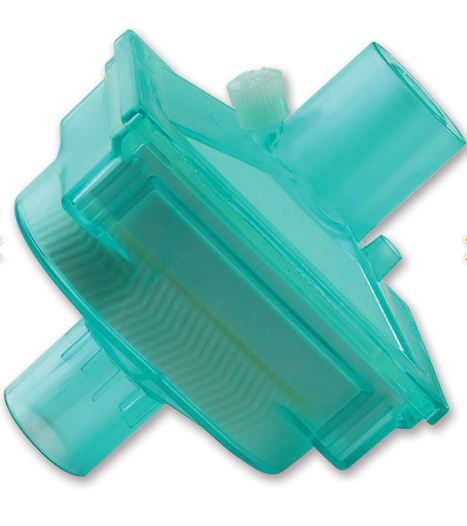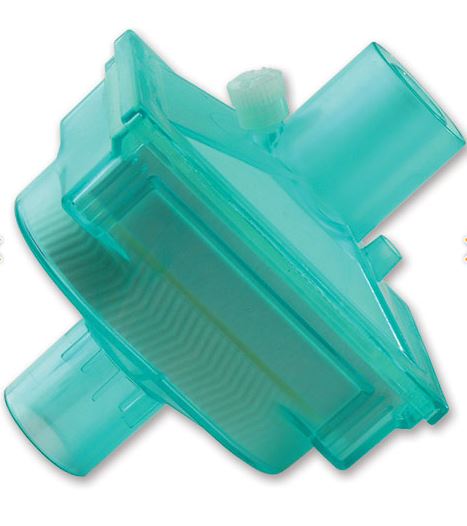FILTER, BREATHING CIRCUIT, 15M/15F, neonate, s.u.
Valid Article
FILTER, BREATHING CIRCUIT
Definition
A non-sterile device intended to remove/filter microorganismsfrom air to prevent patient exposure during respiration and anaesthesia.
It is a small plastic housing containing a filter which will typically also filter other particulates.
Intended for:
- SCTDBRCF1A--: adults and children over 15 kg
- SCTDBRCF1N-: neonates and children below 15 kg
Synonym
BSF: breathing system filter
Specifications
Quality standards
- ISO 23328-1, 2003, edition 1, (confirmed 2014) Breathing system filters for anaesthetic and respiratory use - Part 1: Salt test method to assess filtration performance
- ISO 23328-2, 2002, edition 1, Breathing system filters for anaesthetic and respiratory use - Part 2: Non-filtration aspects
Technical specifications
RIGID BOX
- transparent plastic (enables visual inspection of secretions)
- dead space:
- SCTDBRCF1A--: < 40 ml
- SCTDBRCF1N--: < 18 ml
FILTER
- Type: mechanical filters usually consist of a sheet of densely packed glass fibers that have been resin-bonded. This sheet provides a high resistance to gas flow per unit area due to the dense packing of the fibers. To decrease the resistance to gas flow to an acceptable level, a glass fiber sheet with a large surface area is utilized. The sheet is pleated to maintain a large surface area in a smaller package, also reducing deadspace in the housing. The fiber sheet is hydrophobic, in an effort to minimize water absorption.
- Efficiency:
- 100 – penetration rate
- penetration rate of NaCl particles: the more efficient a filter is, the lower the penetration rate will be
- Bacterial and viral filtration efficiency: 99.999 %
STANDARD CONNECTIONS
SCTDBRCF1A- | SCTDBRCF1N- | |
Patient side | 15F / 22M | 15F / 8.5 F |
Breathing circuit side | 15M / 22F | 15M |
TIDAL VOLUME
- SCTDBRCF1A--: > 150 ml
- SCTDBRCF1N--: 25 – 100 ml maximum
OTHER SPECIFICATIONS
- With or without capnograph port
- Latex-free
- Medically clean: moulded at very high temperature, manufactured and assembled in a clean environment
- For single patient use
Packaging & Labelling
Unit packaging in peel-open pack
Instructions for use
The filter MUST be changed between each patient.
It may be used in an individual patient for a maximum of 24 hours, regardless of the form of ventilation (manual or mechanical).
The filter must be positioned as close as possible to the patient (between the facial mask or the intubation tube and the respiratory assistance device).
Routine use eliminates the need for sterilization of respiratory assistance equipment.





![[KMEDMHHS21-] (mod hospital) SMALL RENEWABLE SUPPLIES 2015](/web/image/product.template/572822/image_256/%5BKMEDMHHS21-%5D%20%28mod%20hospital%29%20SMALL%20RENEWABLE%20SUPPLIES%20%202015?unique=63879bd)
![[KMEDMHCS211] (mod OPD) COMPLEMENTARY RENEWABLE SUPPLIES 2021](/web/image/product.template/574350/image_256/%5BKMEDMHCS211%5D%20%28mod%20OPD%29%20COMPLEMENTARY%20RENEWABLE%20SUPPLIES%202021?unique=e7ad300)
![[KMEDMHDS21-] (mod delivery & neonate) RENEWABLE SUPPLIES compl. 2019](/web/image/product.template/569223/image_256/%5BKMEDMHDS21-%5D%20%28mod%20delivery%20%26%20neonate%29%20RENEWABLE%20SUPPLIES%20compl.%202019?unique=413aa96)
![[KMEDMHOS45-] (mod OT Room) CATHETERS AND DRAINS 2021](/web/image/product.template/574392/image_256/%5BKMEDMHOS45-%5D%20%28mod%20OT%20Room%29%20CATHETERS%20AND%20DRAINS%202021?unique=79faadd)
![[KMEDMHWS31-] (mod ward) MEDICAL RENEWABLE SUPPLIES 2021](/web/image/product.template/574357/image_256/%5BKMEDMHWS31-%5D%20%28mod%20ward%29%20MEDICAL%20RENEWABLE%20SUPPLIES%202021?unique=2ac9064)